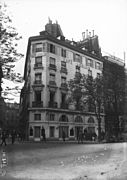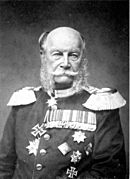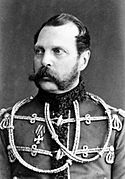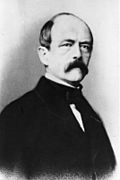Three Emperors Dinner facts for kids
The Three Emperors Dinner was a very special meal held in Paris, France. It took place at a famous restaurant called Café Anglais on June 7, 1867. This amazing dinner had 16 different food dishes and 8 kinds of wine. It lasted for a long eight hours!
A Meal for Kings
This famous dinner was made by a top chef named Adolphe Dugléré. He prepared it for King William I of Prussia. The King often visited the Café Anglais during a big world fair called the Exposition Universelle in 1867.
King William I wanted a meal that everyone would remember. He asked for the best food and drinks, no matter the cost. His special guests were Tsar Alexander II of Russia, his son Tsarevich Alexander (who later became Tsar Alexander III), and Prince Otto von Bismarck.
Even though it's called the "Three Emperors Dinner," only Tsar Alexander II was an emperor at that time. King William I became an emperor later, in 1871. Alexander III became an emperor much later, in 1881. So, the name was given after the event happened.
The restaurant's wine expert, Claudius Burdel, chose the world's best wines. One special wine was a Roederer champagne. It came in a clear glass bottle so Tsar Alexander could see the bubbles and golden color.
The dinner was very expensive, costing 400 francs per person. That would be more than €9,000 today! The rare and old wines were a big part of this high cost.
Around 1 AM, Tsar Alexander said he wished the meal had included foie gras. Burdel explained that it wasn't common to eat foie gras in June in French cooking. The Tsar understood. Later that year, each leader received a gift of foie gras.
You can still see the table used for this famous dinner and a copy of the menu. They are on display at the La Tour d'Argent restaurant in Paris.
The Amazing Menu
Here are some of the 16 dishes served at the dinner:
| MENU
Impératrice Relevés (Main Dishes) Soufflé à la reine Entrées (Appetizers) Poulet à la portugaise Digérer (Digestive Break) Sorbets au champagne Rôts (Roasts) Canetons à la rouennaise Entremets (Side Dishes/Desserts) Aubergines à l'espagnole Dessert Bombe glacée VINS (Wines) Madère retour de l'Inde 1810 |
Here's a closer look at some of the dishes:
- Potage impératrice was a rich chicken soup. It was thickened with tapioca and made creamy with egg yolks and cream. It also had small pieces of chicken, cockscombs, kidneys, and green peas.
- Potage fontanges was a smooth pea soup. It was mixed with a clear broth called consommé. It also had sorrel and chervil herbs.
- Soufflé à la reine was a light, fluffy chicken soufflé with truffles.
- Sauce vénitienne is a sauce made with white wine, tarragon vinegar, and shallots. It's finished with butter and fresh herbs.
- Selle de mouton purée Bretonne was a saddle of mutton served with a purée of broad beans.
- Poulet à la portugaise was a whole roasted chicken. It was covered in a spicy tomato paste and stuffed with tomato-flavored rice.
- Pâté chaud de cailles was a warm pâté made from quail.
- Homard à la parisienne was lobster cooked in a special broth. It was sliced and covered in a clear jelly called aspic. It came with tomatoes filled with mixed vegetables and a mayonnaise sauce.
- Canetons à la rouennaise was a roasted duckling dish. The duck's juices were pressed out and used to make a special sauce. This dish is still a specialty at La Tour d'Argent restaurant today.
- Ortolans sur canapés were small birds called ortolans served on toast. These birds are now a protected species.
- Aubergines à l'espagnole was a dish of aubergine shells. They were filled with chopped aubergine, tomato, ham, and topped with melted gruyère cheese.
- Cassolette princesse was a small dish with a border of mashed potatoes. It had an asparagus filling in a creamy sauce.
- Bombe glacée was a fancy ice cream dessert.
Trying to Recreate It
In 2002, Australian chef Shannon Bennett tried to make the dinner again. It took him six months to plan! He had to make some changes because many original ingredients and wines were no longer available. Even with modern versions, the meal cost $7,500 Australian dollars per person.
The Australian Broadcasting Corporation made a TV show about it in 2003. It showed the original dinner and Shannon Bennett's attempt to recreate it.
Gallery
-
Tsarevich Alexander
(later Tsar Alexander III)
See also
 In Spanish: Cena de los tres emperadores para niños
In Spanish: Cena de los tres emperadores para niños






